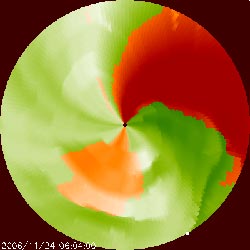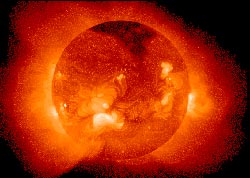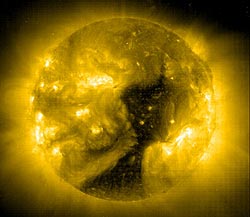
Sun-Earth Day 2007 presents: Living in the Atmosphere of the Sun
We live within the atmosphere of the sun, which extends far beyond Pluto.
ISSUE #55: SOLAR CORONA, HOLES AND WIND
Above the luminous surface of the sun that we easily see, a region called the photosphere, lies the outer atmosphere of the sun. During total solar eclipses, a brilliant corona of light is often seen - our only naked-eye clue to the existence of a solar atmosphere. For centuries, astronomers sketched the delicate details of the solar corona, with no two eclipses revealing quite the same details. Then during the early years of the 20th century, new instruments were brought to bare on the enigma of the corona. The element giving it is ghostly green tinge was found to be none other than oxygen atoms fluorescing under the influence of hot coronal gases. The complex shapes and streamers so commonly sketched were identified as magnetic phenomena in an intimate choreography with solar gases. But just as these discoveries were unfolding, new questions emerged. The most persistent of these had to do with the corona's incredible temperature.
By the 1930's, detailed spectroscopic studies of coronal light forced solar scientists to a compelling conclusion. Despite the 6,000 C solar surface, the more distant solar corona had a temperature that was well above 1 million degrees. For the next 70 years, the problem of the solar corona became well known to students of solar science, and the concerted focus of hundreds of astronomers and solar physicists. Today, several competing theories for coronal heating are being put to the test. One of these suggests that innumerable micro-flares pump energy into the corona by magnetically releasing stored energy in tangled magnetic fields. In another theory, high-frequency plasma waves travel up through the solar surface into the rarefied coronal gases and deposit wave energy, heating the gases in the process. Although there is as yet no consensus on the causes of the million-degree corona, breakthroughs are expected to come from high-speed and high-resolution imaging of the magnetic structure of the sun, where the mechanisms are predicted to be found.

Figure 2: A photograph of the optical corona made with a coronagraph (Courtesy: National Solar Observatory)
Meanwhile, in 1958, Physicist Eugene Parker at the University of Chicago theorized that such a high-temperature gas could not remain for long under the sun's gravity and would tend to expand away from the sun at thousands of kilometers per hour - the solar wind. Some hint that a wind existed had already been considered many times before.
Apart from the many discussions of solar 'corpuscular' radiation in the 1800's to account for aurora, in 1903 Kristian Birkeland in Norway explained aurora as some kind of medium consisting of a stream of electrons that travels from sun to earth. The real turning point for the solar wind concept came 25 years later in 1943 when astronomer Cuno Hoffmeister in Germany provided the crucial observations of a comet gas tail aberration of about 6o, i.e. the angle between the observed tail and the anti-solar direction. Ludwig Biermann (1951) at the University of Gottingen correctly interpreted this deflection in terms of the interaction between the cometary ions in the tail and the solar wind. The tails should always point directly away from the sun if the only thing acting on them was the pressure from sunlight. Comet tails, like million-mile-long windsocks, pointed in the direction that the solar wind was blowing near them. Biermann showed that the pressure from Sunlight was not enough, and that the force must be provided by a stream of particles travelling away from the Sun at speeds of hundreds of kilometers per second.
In 1955, Sydney Chapmen (Britain) concluded that because the corona was so hot (million degrees) that it must exist beyond the orbit of the sun. A few years later, Eugene Parker (U. Chicago) showed mathematically that an expanding, supersonic, hot corona has to produce a solar wind that accounts for comet tail deflections. Despite the work by Hoffmeister, Biermann and Chapman the concept of a solar wind was still considered controvercial by many researchers in the 1950's. This wasn't settled until space probes were flown that were able to record this stream of material high above the Earth's atmosphere, proving its existence. This wind was finally detected by the Mariner 2 spacecraft in 1962.
The solar wind can have a few as a few atoms per cubic centimeter to as many as 50, traveling at typical speeds of 450 km/sec but occasionally gusting to 600 km/sec or more. These gusts produce an invisible wall of pressure that interacts with Earth's magnetic field, triggering magnetic storms and occasionally brilliant aurora.
The solar wind does not blow steadily because of the complex pastiche of magnetic fields covering the solar surface and the corona. When magnetic field lines are confined to the solar surface and inner corona, particles are trapped and cannot escape to great distances. If those lines of force extend into interplanetary space, they can act like magnetic highways allowing fast-moving gases to flow outward into deep space. When satellite images taken by x-ray instruments first looked at the sun, they often found large black areas adjacent to million-degree gases glowing brightly in x-ray light. Called coronal holes these features can be nearly as large as the sun itself, and look like eerie and even ominous voids in the solar atmosphere.

Figure 4: A model of the solar wind from the sun to Earth's orbit showing its complex structure. (Courtesy Karel Schrijver, Lockheed)
Physically, we only see light from the sun where atoms are present to emit the light. If the gas temperature is too low, there may also not be enough light produced to make a region shine. Coronal holes are viewed by selecting the light from atoms that only emit when a critical temperature is reached. For example, Iron atoms normally have 26 electrons, but at temperatures of over 1 million degrees, 13 electrons are stripped away. Detecting light from these heavily ionized iron atoms reveals regions where temperatures exceed one million degrees. In coronal holes, the temperatures may be high enough to allow iron atoms to emit this light, but if the density of the atoms is too low, not enough will be present to reveal light from this region - hence a coronal hole looks dark or even black! The density of gases is low in a coronal hole because the magnetic fields, there, open out into interplanetary space, allowing the atoms to escape the solar vicinity.
When these high-speed coronal wind streams pass across Earth, they can trigger strong gusts of solar wind that lead to magnetic storms here on Earth, and occasionally dazzling aurora such as the one on November 20, 2003.
Technology Through Time
2007 ISSUES
- #57: The Heliosphere
- #56: Coronal Mass Ejections
- #55: Solar Corona, Holes and Wind
- #54: Solar Flares... Oh my!
- #53: Solar Prominences
- #52: Sunspots from A to B - solar magnetism
- #51: The Transit of Mercury
- #50: Ancient Sunlight
- #49: Solar Energy
- #48: The Sun: From Cradle to Grave
View past issues
Authors and Designers
Space Weather Fact
Over $2 billion in satellite technology was damaged or destroyed during the last sunspot cycle.






